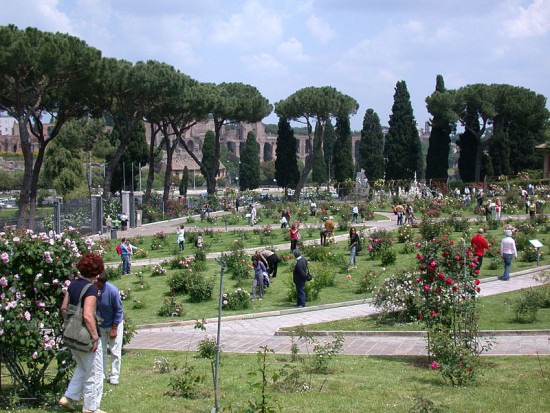Every spring, roses bloom in Rome as well, on the eastern side of the Aventine. Near the Circus Maximus, there is a unique Municipal Rose Garden, where at the end of April a marvellous spectacle takes place: the flowering of something like a thousand different species of roses. An event not to be missed by those who happen to find themselves in town at this time of the year. The rose garden is open from spring until October, remaining closed for most of the year, so it is imperative to take advantage of the opportunity to enjoy the landscape and the vegetation.

The size of this green area is quite substantial and consists of about one hectare of land; what surprises is the beauty of the rose varieties that bloom there. The access areas are along Via di Valle Murcia. As for its history, we know that the rose garden was established in the thirties of the twentieth century by will of Prince Francesco Boncompagni Ludovisi, prompted, in turn, by Countess Mary Gayley Senni. This woman, originally from Pennsylvania, an expert in botany and particularly sensitive to the charm of these flowers, was curator of the various editions of the Rome Prize for New Variety of Roses, established in 1933. She travelled extensively through Europe and married Giulio Senni. She resided in her villa in Grottaferrata, and in 1924 donated to the City of Rome the first nucleus of what would later become the city’s rose collection.
The area where now stands the rose garden, named Valle Murcia, is actually an area frequented since antiquity. Here, in the third century BC, rose a temple dedicated to the goddess Flora. The Roman historian Tacitus tells us about it in his Annales, where he refers to a small place of worship. The festivities in honour of the goddess were here called Floralia and took place in the Circus Maximus.
We know that the area was also home to the Jewish cemetery during the seventeenth century, before it was transferred to Verano and that is why the area was called “Ortaccio (pejorative of vegetable garden) of the Jews“. As for the temple, of which today remains unfortunately no material trace, we know that it was dedicated to Flora, the goddess of spring and flowers. In ancient times, the Romans officiated in her honour the celebrations that took place at the end of April.

Rosa Clair Matin.
Today the collection includes 1,100 different species of roses and is divided into “botanical roses”, “antique roses” and “modern roses”. The rose garden is considered to be among the most beautiful in the world, and the varieties of roses come from various countries, even from Mongolia and China.
Among the species to observe and admire are the Rosa Chinensis Mutabilis, which changes colour day after day, and even a kind of rose which instead of releasing a delightful perfume, is characterized by an unpleasant odour, in fact, called Rosa Foetida (stinky rose).

Rosa Tequila-Meilland


